Saco - 2011
'09 maps for:
Bea
--
Buck -- Caley --
Claws --
Conomo --
Hix --
Hudson 09 -- Isabel --
Katy -- L.R. --
Moffet --
Mr. Hannah --
Ozzie --
Penelope
--
Rafael
2010 maps for: Belle
-- Buck --
Gunny --
Hudson --
Mr. Hannah --
Neale --
North Fork Bob
--
Penelope --
Sanford
-- Sr. Bones --
Thatch
2011 maps:
Belle --
Buck --
Henrietta --
Katbird
-- North Fork Bob --
Pemi --
Saco --
Sanford --
Sr. Bones --
Snowy --
Thatch -- Tucker
2012 maps: Art --
Belle --
Bridger --
Chip --
Cutch --
Jill -- North Fork Bob --
Rammie --
Snowy --
Sr. Bones -- Thatch
2013 maps: Art --
Belle --
Bridger --
North Fork Bob --
Rammie --
Snowy --
Sr. Bones
Osprey
main page --
Migration
page --
Migration09 --
Migration10 --
Migration 11 --
Migration 12 --
Migration 13 -- Home
Page
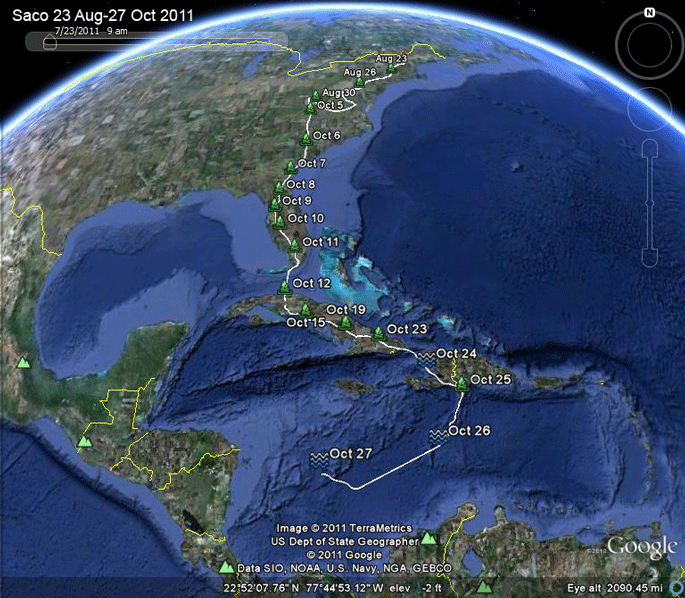 |
15 Oct 2011: Saco was the first of our
birds to head south this season. It was a bit of
a shock to see her go, as she hadn't been more
than 0.4 miles from her nest since she fledged. Her track is similar to that of Homer, a Vineyard youngster who was pushing south and then turned around and moved north, where he stayed for about a month before resuming his migration. She is moseyed down the Highway to the Tropics at a rather leisurely pace, crossed over to Hispaniola on the 24th, and kept right on going out over the Caribbean. She apparently ran into some bad weather over the Caribbean and got blown west. She went down 28 hours after leaving Hispaniola. That's not an unreasonable amount of time to be flying--many of our young fly 50 hours over the Atlantic. It is a long time, however is she got caught in bad weather. Scroll down for all her maps, or Skip ahead to the restart of migration. |
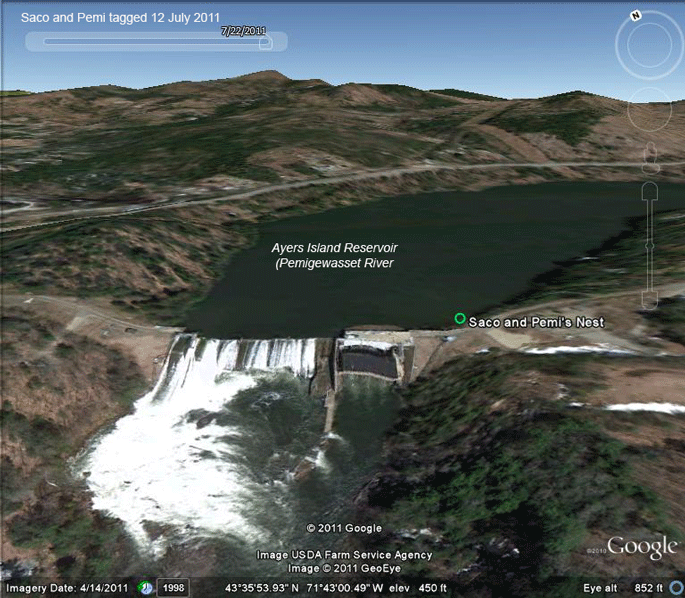 |
12 July 2011: Pemi and Saco were
outfitted with satellite transmitters on 12
July. Their younger nest mate was banded, but
not tagged. Saco
was 6 weeks and 4 days. Pemi was probably a
couple of days younger. Sadly, Pemi died shortly after fledging when he missed a landing (always the toughest thing to learn for young birds) and got caught up in some dense vegetation and fell prey to a fox or coyote. |
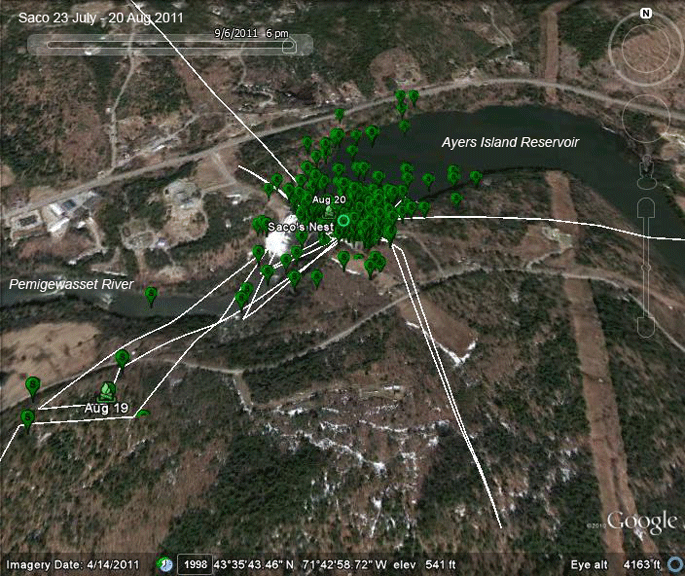 |
23 July-20 Aug 2011: Saco took her first flight in late July. For almost a month she stayed closer to home than any other juvenile we have tracked. The farthest she ventured from her nest was 0.4 miles! There must be a whole lot of fish in the reservoir. |
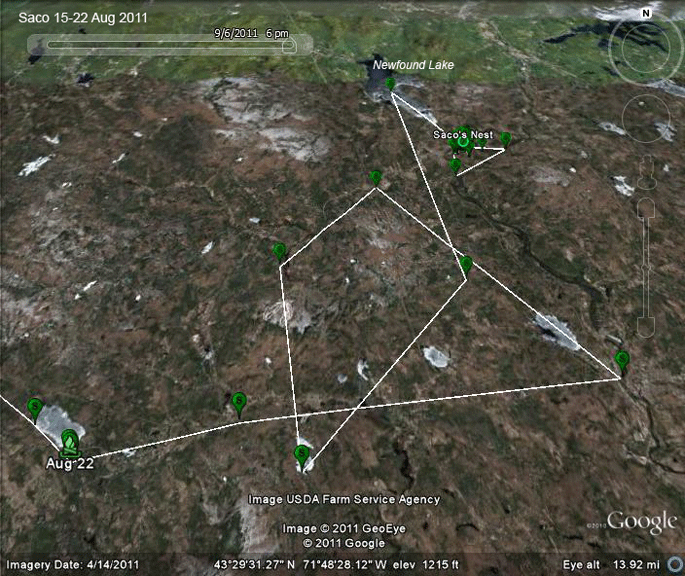 |
15-22 Aug 2011: Two days after an
adventurous trip of almost 2 miles(!) from her
nest on the 20th, the migration urge kicked in.
She moved up to Newfound Lake in the morning and
then circled around a bit, waiting for her
compass to kick in, we suppose. Her first roost was at a small beaver pond just south of Pleasant Lake. |
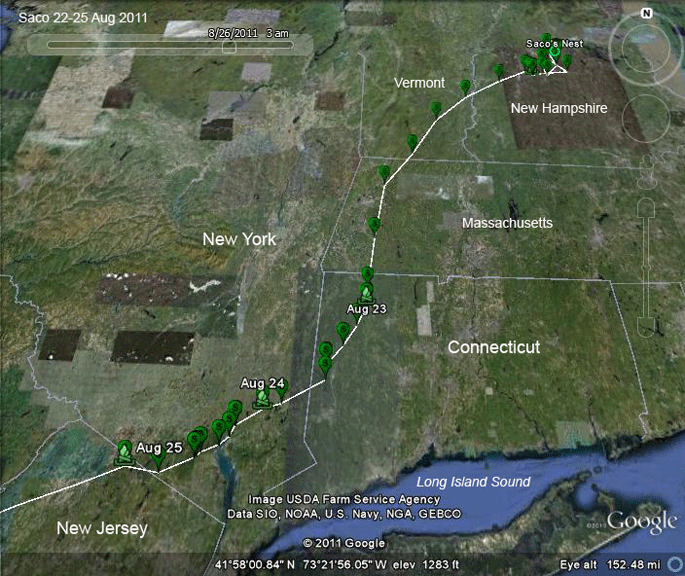 |
22-25 Aug 2011: The 23rd saw her kick into
migration mode. By the 25th, she was down in New York, having crossed the Hudson River on the 24th. At this point, Hurricane Irene was lumbering up the eastern seaboard. This made us nervous, given our dismal luck last fall as Ospreys ran into hurricanes. We felt a little better about this, as all our birds were over land, and only Saco had begun real migration. |
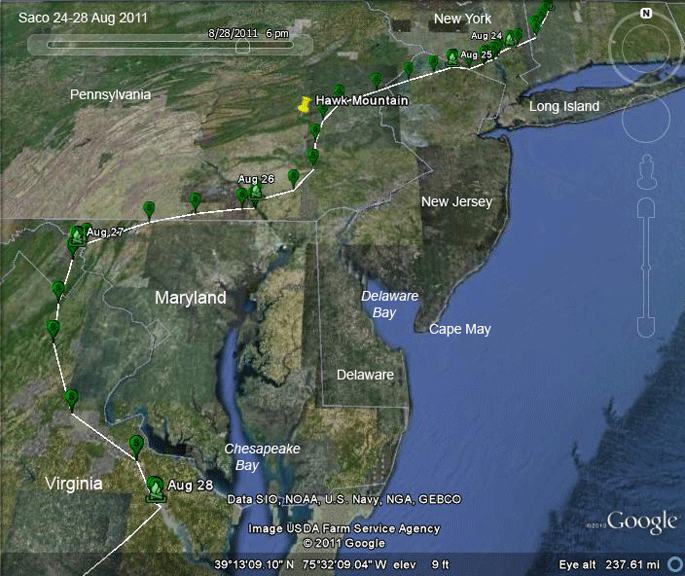 |
26-28 Aug 2011: As Irene approached, Saco
got a boost from the northeasterly winds that
precede hurricanes and knocked off 150 miles.
She flew pretty close to Hawk Mountain, but was
out of range (about 10 miles east), so she
didn't make the data sheets for the count that
day. She roosted near the Susquehannah River in PA on the 26th. The next morning she spent some time below the Holtwood Dam, which must have felt just like home! Next on to the Potomac, and then the Rappahannock River on the 28th. |
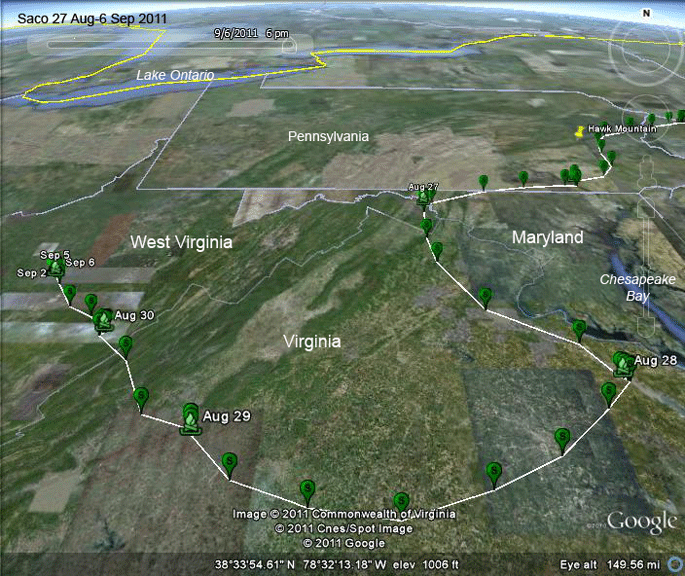 |
28 Aug-6 Sept 2011: This looks like what
Homer did way back in '05. Homer crossed the
NC/VA border in full migration mode and then
turned around and went back up into Virginia,
where he spent a month on the Shenandoah River. Saco made it all the way up into West Virginia, where she has found another spot that much look just like the Ayers River Dam, just a bit bigger. |
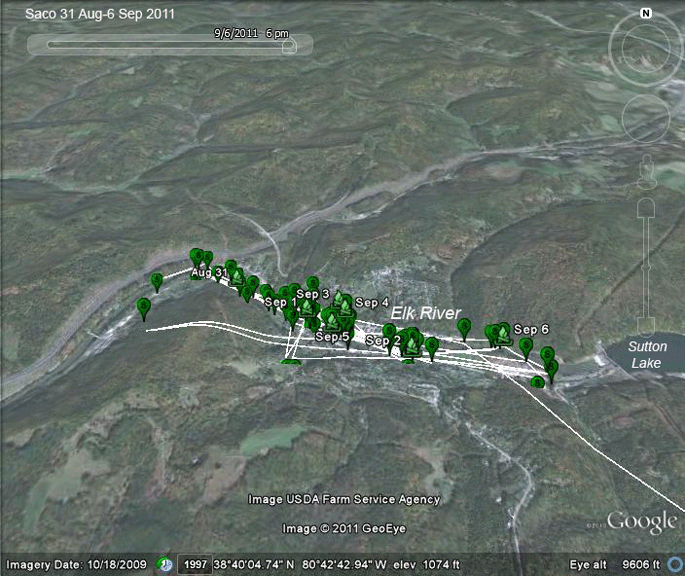 |
31 Aug-6 Sept 2011: Saco seems to like the fishing below the Sutton Lake dam on the Elk River. The weather during this period was awful. The remnants of Hurricane Lee were stuck in the eastern US for days, drenching the area with seemingly endless rain. Not the kind of weather that inspires migration. |
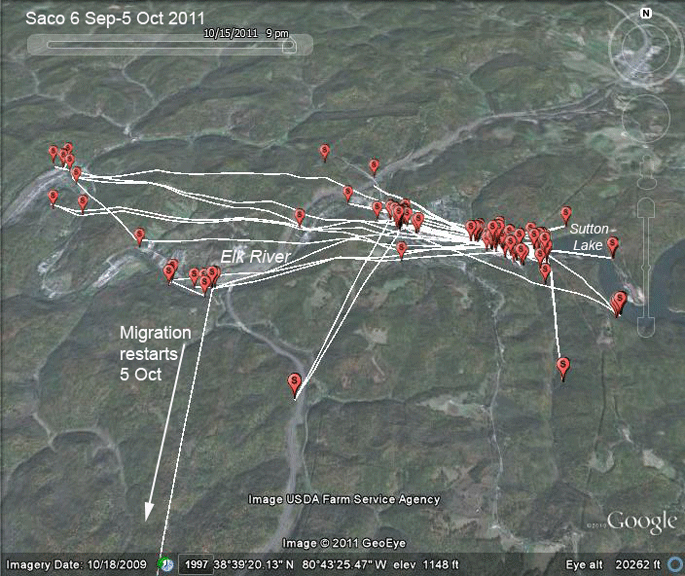 |
6 Sept-5 Oct 2011: Saco spent just over a month on the Elk River in West Virginia before restarting her migration on Oct 5th. |
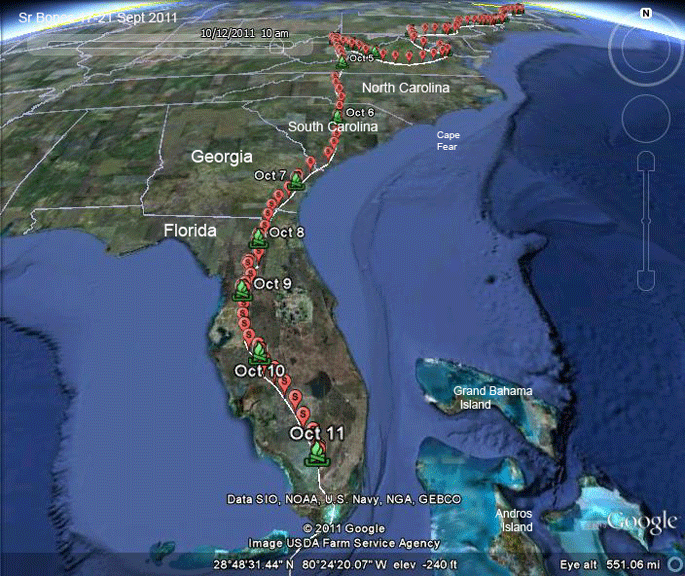 |
5-11 Oct 2011: Saco finally got going and
headed down to Florida on the 5th. By Oct. 11th,
she had traveled 1,843 miles (2,966 km) during
17 actual migration days. She left her nest area
51 days ago. She's averaging 108 miles/day of actual migration (174 km/day), which is a bit below the average for all the birds we've followed. |
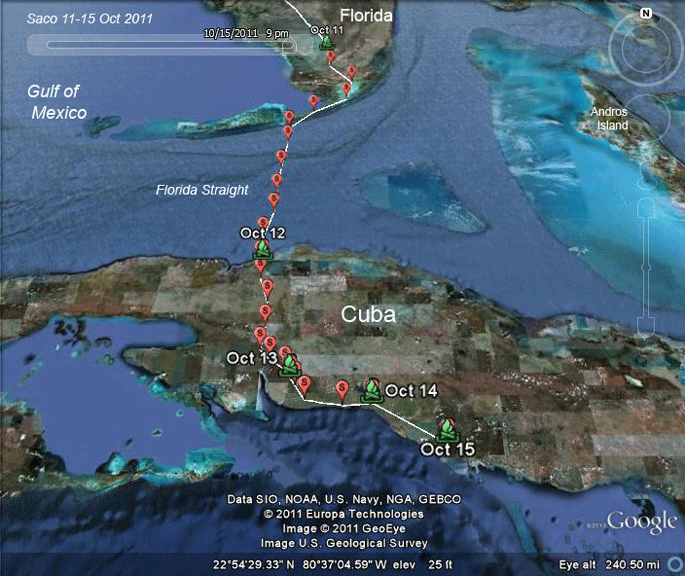 |
11-15 Oct 2011: Saco left her roost in the
Everglades around 10 AM on the 12th. About 4
hours later she left the Keys and headed across
the Florida Straight. Six hours later she was on
Cuba's north shore. Over the next three days, she moved over to the south shore. On the 14th, she stopped at Cien Fuegos, where our adult male, Ozzie, spent a winter back in 2010. On the 15th, she stopped near Trinidad. |
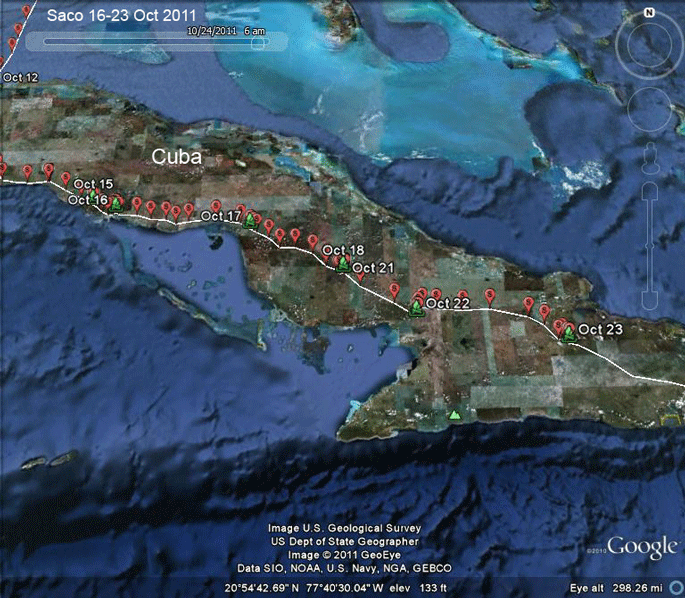 |
16-23 Oct 2011: Saco took her time working southeast through Cuba. She only moved 15 miles on the 16th, then 80 on the 17th and 60 on the 17th. She settled down for three days near El Jobo. She moved 50 and then 80 miles on the 22nd and 23rd. |
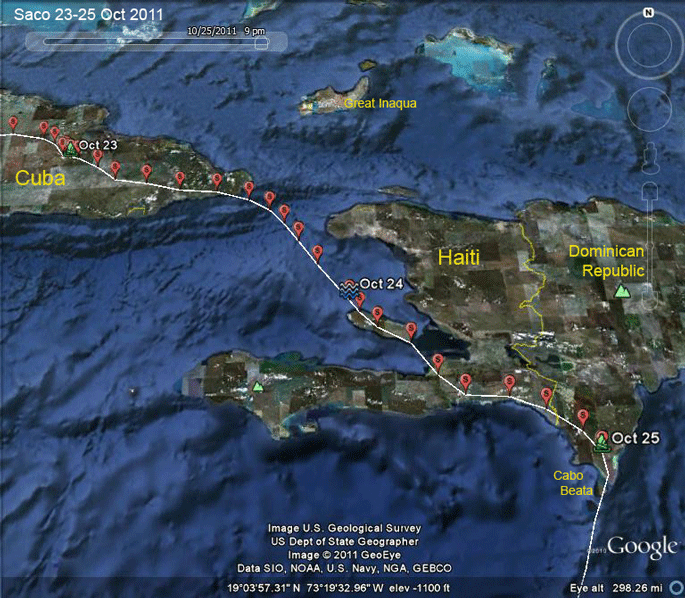 |
24-25 Oct 2011: Saco left her roost area
just before 10 AM on the 24th and left Cuba
behind around 3:30 PM. She covered 93 miles
averaging about 19 mph. At 9 PM, when we got our
last signal for the day, she was just 8 miles
from land. For the first 4.5 hours of this
over-water leg she was plodding along around 15
mph. The wind must have shifted dramatically,
because she covered 28 miles in the hour before
the last fix for the day. On the 25th she started around 10 AM and settled down for the night on Cabo Beata around 5 PM. |
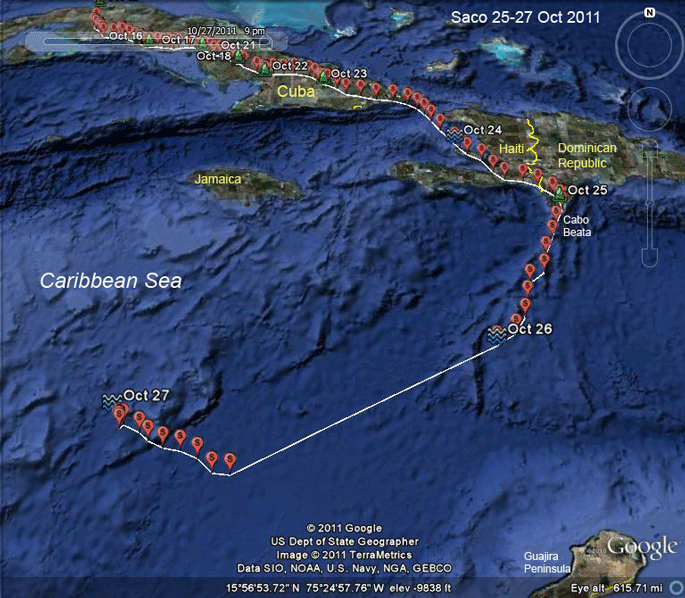 |
26-27 Oct 2011: She left around 9:30 AM. About 9 hours later she was 208 miles into the crossing, averaging 23 mph. 15 hours later, when her GPS turned on for the 27th, she had covered another 309 miles, so she was still over 20 mph average for this period. And it was probably a bit more than that, because her track wouldn't have been the very straight line we see on this map, but something more curving. Somewhere in here, she must have run into bad weather that pushed her north and west of her intended direction. She was down to about 18 mph during this period, and then hit the water around 6 PM. |
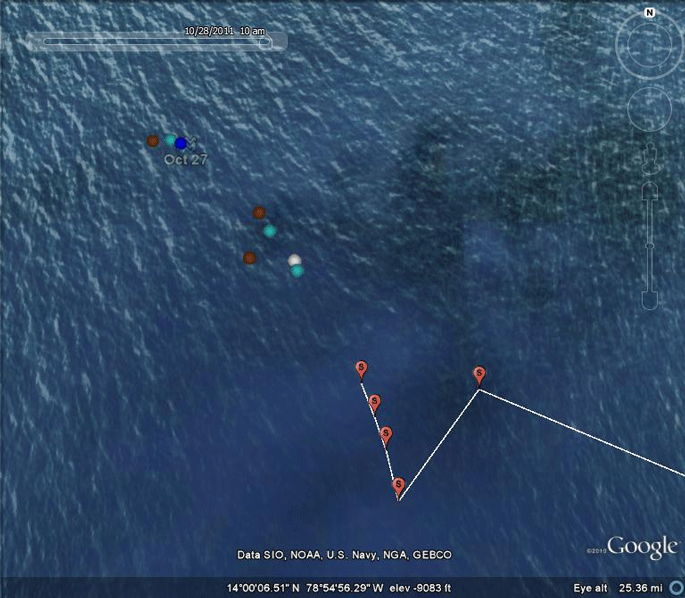 |
27 Oct 2011: I hoped she was on a boat at
this point, but now know that she was dead. The
signal was moving about 2 mph, and continued to
move northwest sending signals to the satellite
for another 14 hours. Presumably it was just her
body floating in the current. I hate writing Osprey obituaries. |